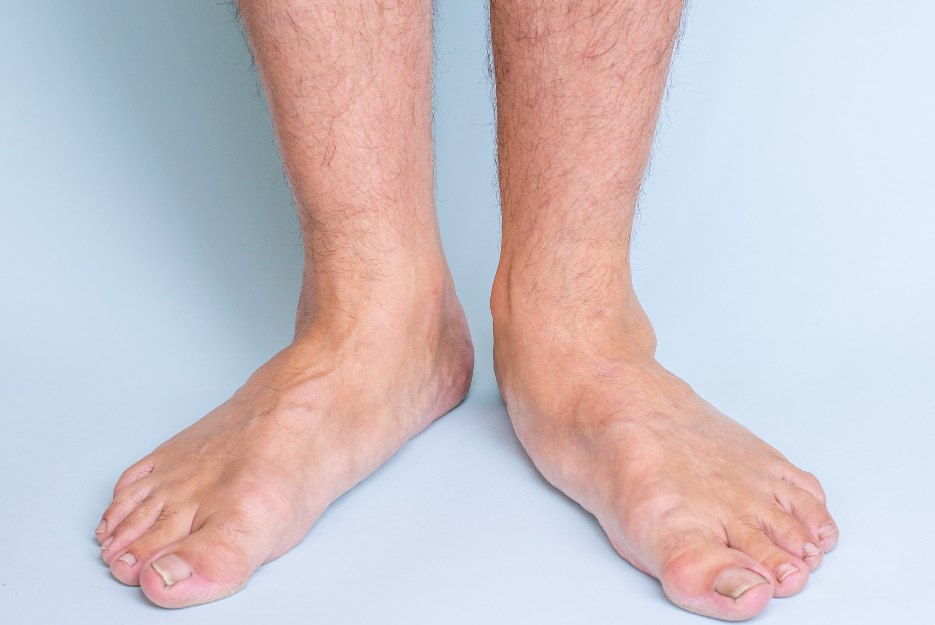Flat Feet Treatment
What Are Flat Feet?

Table of Contents
What Causes Flat Feet?
Excess pronation can be caused by several factors, including:
- Hypermobility: This refers to increased flexibility due to laxity in the tissues and ligaments, including those in the feet, leading to pronation. This affects about 10% of the population.
- Soft tissue injuries: Conditions like posterior tibial tendon dysfunction can contribute to pronation.
- Hereditary conditions: Bony or soft tissue abnormalities in the foot can disrupt normal walking patterns, causing the foot to “unlock” and the arch to fall toward the ground.
- Abnormal muscle length or weak muscles: These can contribute to pronation.
- Pregnancy and hormonal changes: Hormonal shifts can affect the ligaments and joints, contributing to pronation.
- Medical conditions: Conditions like arthritis and diabetes can affect foot function and lead to excess pronation.
- Abnormal leg rotations: These can cause changes in the mechanics of the feet and lead to pronation.
- Leg length differences: Uneven leg lengths can lead to compensatory pronation.
- Spinal conditions: Issues like scoliosis can affect posture and lead to pronation.
- Muscle spasticity: Conditions such as cerebral palsy can cause muscle tightness, contributing to abnormal foot mechanics.
The impact of pronation varies from person to person. Some may not experience any symptoms, while others may experience pain due to the abnormal forces pronation places on the body, potentially leading to a range of bone and soft tissue issues.
Flat Foot Symptoms
- Feet: Bunions, hammertoes, corns, calluses
- Heels: Plantar fasciitis, heel spurs, heel pain, Sever’s disease
- Shins: Shin splints, posterior tibial tendinopathy (PTTD)
- Knees: Patellofemoral syndrome, chondromalacia (runner’s knee), Osgood-Schlatter’s disease
- Thighs: Iliotibial band syndrome
- Hips: Greater trochanter bursitis
- Upper and lower back: Sciatica, disc protrusion
- Neck and head: Poor postural alignment, which may be related to conditions like kyphosis
You may also notice that the inside edges of your shoes wear out faster and observe some “bulging” on the inside of your ankle.
Visit Us Today
Hope Island
Phone: 07 5510 9222
Located within Hope Island Marketplace Medical & Skin Clinic, 99-103 Broadwater Ave Hope Island QLD 4212
Jimboomba
Phone: 07 5546 9766
Located Within Jimboomba Medical Centre, Unit 1/69 Cerina Cct, Jimboomba QLD 4280
Beenleigh
Phone: 07 3287 2224
Located Within Beenleigh Mall Medical Centre, Shop24A, 40/68 Main Street, Beenleigh QLD 4207
Eagleby
Phone: 07 2889 1666
Located Within Eagleby Family Practice, 5/120 River Hills Rd, Eagleby QLD 4207
Harristown
Phone: 07 4635 6111
Located Within Toowoomba Medical Centre, 146 Drayton Road, Harristown QLD 4350
Marsden
Phone: 07 3067 2370
Located Within Marsden Family Doctors, Shop 28/55-77 Chambers Flat Rd, Marsden QLD 4132
Keperra
Phone: 07 3355 4082
Located Within Keperra Medical Clinic, 14 Dallas Parade Keperra QLD 4054
Coomera
Phone: 07 5573 5663
Located Within Doctors @ Coomera Central, Shop 6, 21 Coomera Grand Drive, Upper Coomera, QLD 4209
Newtown
Phone: 07 4633 8700
Located Within Ochre Medical Centre Wyalla, Shop 20, 238 Taylor Street, Newtown QLD 4350
How To Treat Flat Feet
We use computerised video gait analysis software to analyse your walking pattern and assess how any abnormal forces may be affecting your gait. Afterward, your podiatrist will discuss treatment options, which often include custom foot orthotics designed to address any abnormal forces contributing to foot pain, leg discomfort, or other symptoms.
A 3D scan of your feet is taken, and a detailed prescription is created for your orthotics. These orthotics are tailored to fit comfortably inside your footwear, supporting your feet and arch in the most optimal position to help improve alignment, posture, and relieve strain from overused muscles.
Your podiatrist will also recommend the best footwear for your feet and ensure your current shoes are not hindering your recovery. Proper footwear is crucial for supporting and stabilising your feet, improving the efficiency of your muscles, joints, bones, and ligaments.
Your treatment plan will be fully customised based on your symptoms and the underlying cause of your flat feet. This plan may also include exercises, mobilisation, manipulation, massage, footwear recommendations, postural balance programs, and more. All of these treatment options will be discussed with your podiatrist if they are deemed necessary.
Enquire Now
Flat Feet FAQ's
Are flat feet permanent?
is walking barefoot good for flat feet?
How to relieve pain from flat feet
What kind of shoes are good for flat feet?
Shoes with built-in arch support are an excellent starting point for managing flat feet. They help provide stability and support for the foot and ankle. It’s important to choose shoes suited to your specific activity, whether it’s exercise, work, or daily wear. For optimal support, the shoes should wrap around the ankle and feature secure fastening mechanisms, ensuring the foot remains stable and well-supported throughout the day.
Not The Condition You Are Looking For?
Find out more about the conditions we treat by clicking below.
